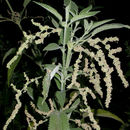More info for the terms:
competition,
cover,
density,
forest,
frequency,
litter,
marsh,
rhizome,
seed,
wildfireStinging nettle regenerates from buried rhizomes and/or seed after fire.
Stinging nettle bloomed during the first postfire growing season on a
ravine site in western Montana that burned in mid-July. Although
stinging nettle thrives on disturbance, its rate of spread after the
fire on this site may have been slowed by competition from orchard grass
(Dactylis glomerata) [
8].
One year after a wildfire in northern Utah, stinging nettle was present
at low frequency on plots in a burned Gambel oak (Quercus gambelii)
brush community but was not present on adjacent unburned plots [
30].
In southern California, large amounts of sediment were deposited in a
riparian zone after a July fire in a riparian forest dominated by coast
live oak (Q. agrifolia), white alder, and California sycamore. Stinging
nettle emerged from the sediment and was a common species on lower and
middle terraces in the riparian zone during the 3 years following the
fire [
9].
Stinging nettle occurred in a central Wisconsin marsh dominated by
goldenrod (Solidago spp.), butter-and-eggs (Linaria vulgaris), white
meadowsweet (Spiraea alba), and grasses. Fire was prescribed on two
sites in the spring 1 week after snowmelt. Approximately 96 percent of
the dry surface fuels were eliminated. Vegetation was inventoried
during the growing seasons before and after the fires. Stinging nettle
prefire and postfire covers are as follows [
19]:
Prefire cover Postfire cover
Site 1 2.0% 1.8%
Site 2 less than 0.5% 2.5%
Stinging nettle shoot density and biomass after fire depends on the
season of burn. Stinging nettle shoots per square meter and biomass
measured the first growing season after each fire in a common reed
(Phragmites australis) stand in Delta Marsh, Manitoba, are as follows:
Density Biomass
(nonseedling shoots/sq m) (grams/sq m)
Control 6.7 36.2
Summer fire 18.4 33.9
Fall fire 4.9 10.3
Spring fire 18.8 52.9
Stinging nettle biomass was less than in the control the first growing
season after the fall fire. The authors suggest that the stinging
nettle rhizome buds may have succumbed to winterkill after the fall fire
because there were no dead standing canes to trap snow and insulate the
soil. Stinging nettle biomass was greater than in the control in the
first growing season after the spring fire. Stinging nettle is capable
of fast growth and, with the removal of common reed litter by fire, was
able to compete with the common reed. Stinging nettle biomass did not
differ substantially from the control 1 year after the summer fire.
There were more shoots per meter after the summer fire but the shoots
were smaller than in the control, possibly because resources were depleted
by regrowth immediately after the summer fire [
43].
Stinging nettle seedlings established at a density of 6.9 seedlings per
square foot (76.8/sq m) 1 month after the summer fire. Only a few
seedlings established after the fall and spring fires [
43].

